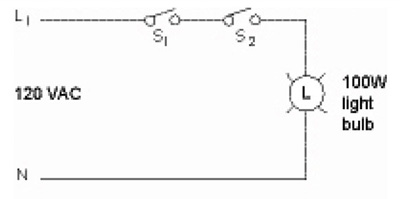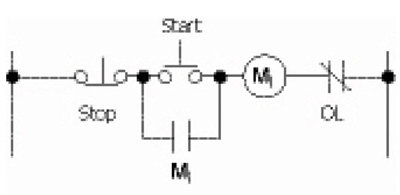 Electric machines are very useful and efficient devices which operate through a variety of control circuits. These control circuits are made up of input devices that sense a condition or situation and output devices that make adjustments to change the situation. The symbolic language for this process is called ladder logic. Many of the diagrams used resemble the steps of a ladder; hence, the addition of the word “ladder” into the title.
Electric machines are very useful and efficient devices which operate through a variety of control circuits. These control circuits are made up of input devices that sense a condition or situation and output devices that make adjustments to change the situation. The symbolic language for this process is called ladder logic. Many of the diagrams used resemble the steps of a ladder; hence, the addition of the word “ladder” into the title.
It is important also to discuss the term logic. In the study of digital electronics, devices are used that operate in either an on state or an off state. A specialized branch of mathematics called Boolean algebra analyzes this relationship with two numbers — a zero [0], which represents the off state; or a one [1], which represents the on state. These two numbers comprise the binary number system.
The most common logic functions are and, or and not. Think of a single-pole light switch in your home that controls a 100W light bulb. The switch can either be off[0] or on[1]. Now imagine we place two single-pole switches in series to control the same 100W light bulb. In this condition, switch 1 and switch 2 both have to be on[1] to light the 100W bulb; this is an example of an and operation (see figure 1). Logic relates to ladder diagrams because input functions in series constitute and operations, while input functions in parallel constitute or operations.
Two Types of Ladder Diagrams
Two-wire control circuits

Figure 1. “And” Circuit
You will encounter two types of ladder diagrams: the two-wire control circuit and the three-wire control circuit. The two-wire control circuit is shown in figure 2. This circuit is used to start a motor for some industrial process. The components in a two-wire control circuit are a maintained contact switching device (S1), a relay coil (M1), and the thermal overload relay contact (OL). The sequence of operations is fairly simple when S1is closed, the coil of magnetic motor starter M1 is energized and the motor starts, provided the running overload current is within the value of the overload relay OL. To stop the motor, S1 is simply opened.
Three-wire control circuits
The three-wire control circuit is shown in figure 3. Again this circuit is used to start a motor for some industrial process. The components in a three-wire control circuit are a momentary push-button (STOP), a momentary push-button (START), a normally open relay contact (M1), a relay coil (M1), and the thermal overload relay contact (OL). The sequence of operations here is a little more complex. When the start button is pressed, the coil of magnetic motor starter M1 is energized and the motor starts, provided the running overload current is within the values of the overload relay OL. However, there is one very important difference: a normally open contact of magnetic motor starter M1seals around the start button to latch the circuit. To stop the motor, the STOP button is pressed which, in turn, breaks the latch and de-energizes the coil of magnetic motor starter M1; the motor stops.

Figure 2. Two-wire control circuit
Diagram Components
If you review the traditional ladder diagram of a standard three-wire control circuit as shown in figure 3, you will notice several components: a normally closed stop button, a normally open start button, a normally open relay sealing contact, a relay coil, and a normally closed thermal overload relay contact. This figure also resembles a step ladder with each rung of the ladder representing a specific input or output function, and it demonstrates where the term ladder diagram comes from. Figure 4 provides additional common symbols used in ladder diagrams and motor control circuits.

Figure 3. Three-wire control circuit
![Figure 4. Common symbols [N.O. means normally open; N.C. means normally closed] Figure 4. Common symbols [N.O. means normally open; N.C. means normally closed]](http://iaeimagazine.org/images/2012_05/12c_VidalFig4.jpg)
Figure 4. Common symbols [N.O. means normally open; N.C. means normally closed
Input Devices
Momentary contact and maintained contact devices
What components make up a ladder diagram? There are several types of input devices and output devices. For the purpose of this article, we will focus on conventional electromechanical devices. Input devices can first be classified as momentary contact and maintained contact devices. Momentary contact devices are spring-loaded and are classified as normally open and normally closed devices. The designation “normally” refers to the state of the device in its resting position when no external stimulus is acting upon it. The contact arrangement of switching devices can also be classified as SPST, SPDT, DPST, DPDT, 3PDT, etc. The first two letters refer to the number of “poles,” and the last two letters refer to the number of “throws.” For example, SPST refers to a single-pole, single-throw contact. 3PDT refers to a three-pole, double-throw contact. A fractional manual motor starter useful for single-phase motors, 1HP and lower, can either be a SPST for 120-V applications, or DPST for 240-V applications. A green start button is an example of a normally open momentary push-button, while a red stop button is an example of a normally closed momentary push-button.
Maintained contact devices are not spring-loaded; they remain in either an on state or an off state. They can also be classified as normally open and normally closed. An emergency stop is an example of a maintained contact device. Temperature sensing devices commonly used are thermostats and thermocouples. A thermostat relies on the thermal expansion/contraction of a bimetal, while a thermocouple relies on a principle known as the Seebeck effect. Two dissimilar metal wires are joined together in a loop with one end being the hot junction and one end being the cold junction. A difference of potential is generated in the loop in response to temperature change. Each of these devices sense temperature change and then presents a contact closure for use in a control circuit.
Motion Sensing Devices
Photoelectric controls and proximity controls
Motion sensing devices commonly used are photoelectric controls and proximity controls. Early versions of photoelectric controls had an incandescent lamp transmitter and a cadmium sulfide photocell receiver. Modern versions of the photoelectric control have pulsed infrared transmitters and solid state photo-detector receivers. They work on the principle of beam interruption to sense motion and then present a contact closure to the control circuit. Proximity controls sense motion when an object passes by the sensing target on the device. They can detect metallic as well as non-metallic objects. They operate on the principles of magnetism and capacitance, and then present a contact closure to the control circuit. Limit switches are the most versatile device in terms of motion detection. They are available in a variety of operator mechanisms and contact arrangements. They work on the principle of physical contact between an object and the operator mechanism to present a contact closure to the control circuit.
Liquid level sensing devices
The most commonly used liquid level sensing device is the float switch, which operates on the principle of buoyancy. The float is suspended in a liquid bath and as levels of the liquid rise and fall, the float moves. This movement of the float presents a contact closure to the control circuit.
Pressure sensing devices
The most commonly used pressure sensing device is the pressure switch. The diaphragm, or bellows, in a pressure switch monitors the change in pressure and presents a contact closure to the control circuit.
Other types of input devices include the foot switch, the selector switch, or even the contact of a control relay or a timing relay. These are all mechanical devices that present a contact closure to the control circuit.
Output Devices
Relay coils
Outputs of the control circuit can be relay coils, pilot indicating lights, audible devices, etc. To use the generic term relay coil, we need further classification into magnetic motor starter, contactor, and relay. A magnetic motor starter is a relay with a coil and contacts as well as running overload protection by means of thermal overload relays. Bi-metallic thermal overload relays are units made of a heater coil that heats a coil of wire to a specified temperature based on overload current, and a bimetal unit that expands/contracts and operates a contact. Solder pot thermal overload relays use a similar heater coil and a eutectic solder that melts under overload conditions and correspondingly turns a ratchet wheel to operate a contact. The contact arrangement on the thermal overload relay is normally closed but will open under excessive current conditions and de-energize the coil of the magnetic motor starter and consequently disconnect the motor. Contactors are also relays that switch high-load currents but do not provide running overload protection via the thermal overload replay. Control relays are usually designed to switch small control circuit currents. Common types of timing relays are on-delay (delay on operate), off-delay (delay on release), interval delay, and repeat cycle delay. Time delay relays are used for timing in control circuit.
Pilot indicating lights
Pilot indicating lights are used to provide visual indication of a function or verify that a certain operation is either on or off.
Audible sounding devices
Audible sounding devices are used to indicate trouble with a process or alert the user to a particular situation.
Standard motor control circuits will be covered in the next issue.










Find Us on Socials